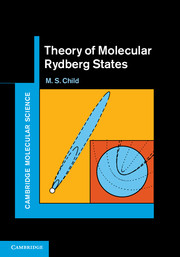Book contents
- Frontmatter
- Contents
- Preface
- 1 Molecular Rydberg states
- 2 The quantum defect picture
- 3 Ab-initio quantum defects
- 4 Frame transformations and channel interactions
- 5 Competitive fragmentation
- 6 Photo-excitation
- 7 Photo-ionization
- 8 Manipulating Rydberg states
- Appendix A MQDT normalization
- Appendix B Alternative MQDT representations
- Appendix C Rotational frame transformations
- Appendix D Optical transition and photo-ionization amplitudes
- Appendix E Generalized MQDT representation
- Appendix F Notation
- Index
- References
3 - Ab-initio quantum defects
Published online by Cambridge University Press: 07 October 2011
- Frontmatter
- Contents
- Preface
- 1 Molecular Rydberg states
- 2 The quantum defect picture
- 3 Ab-initio quantum defects
- 4 Frame transformations and channel interactions
- 5 Competitive fragmentation
- 6 Photo-excitation
- 7 Photo-ionization
- 8 Manipulating Rydberg states
- Appendix A MQDT normalization
- Appendix B Alternative MQDT representations
- Appendix C Rotational frame transformations
- Appendix D Optical transition and photo-ionization amplitudes
- Appendix E Generalized MQDT representation
- Appendix F Notation
- Index
- References
Summary
The previous chapter laid out the principles of multichannel quantum defect theory, showing in particular how knowledge of the quantum defects or scattering K-matrices are built into a unified theory of Rydberg spectroscopy and ionization dynamics. This chapter deals with the ab-initio determination of these quantum defects. We know from the discussion in Chapter 1 that they arise from interactions between the positive ion core and the Rydberg electron, which were seen to occur on a timescale far shorter than that of the molecular vibrations and rotations. It is therefore natural to compute them within the fixed nucleus Born–Oppenheimer approximation. Useful information on the lowest members of a given series may be obtained by traditional Hartree–Fock and configuration interaction techniques [1]. Carefully designed diffuse Rydberg orbitals are, however, required [2]. The resulting information is normally limited to the potential energy surfaces for principal quantum numbers n ≤ 4, from which it may be difficult to extract the desired forms of the quantum defects, as functions of the nuclear coordinates, particularly for polyatomic molecules. An alternative is to recognize that the distant outer parts of the Rydberg wavefunction may be expressed as Coulomb functions. Thus the ab-initio effort may be restricted to a finite volume, chosen to be large enough to allow a proper treatment of all Rydberg–core interactions [3, 4, 5, 6]. The inner and outer wavefunctions are then joined at the core boundary by a so-called R-matrix, from which the scattering K-matrix may be obtained directly, without reference to information on any potential energy surfaces.
- Type
- Chapter
- Information
- Theory of Molecular Rydberg States , pp. 45 - 89Publisher: Cambridge University PressPrint publication year: 2011

